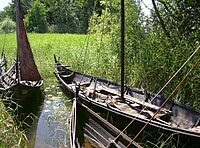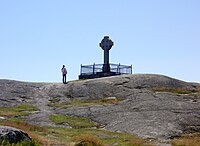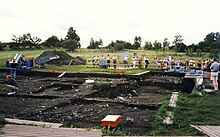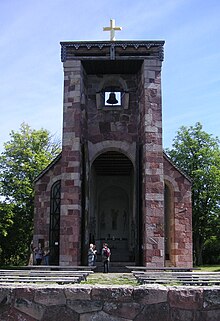Birka
| Birka and Hovgården | |
|---|---|
|
UNESCO world heritage |
|

|
|
| Viking trading centers |
|
| National territory: |
|
| Type: | Culture |
| Criteria : | (iii), (iv) |
| Reference No .: | 555 |
| UNESCO region : | Europe and North America |
| History of enrollment | |
| Enrollment: | 1993 (session 17) |
Birka and Hovgården , located on two neighboring islands ( Björkö and Adelsön ) in Sweden's third largest lake, Mälaren , were added to the World Heritage List in 1993. They bear testimony to the trading network of the Vikings in the 200 years in which they expanded economically and politically in Europe. Birka was the most important trading center in Scandinavia from the 8th to the 10th century, while the king's residence was on Adelsön near Hovgården .
history
Trade centers were established in northern Europe as early as the 8th century AD. These include Ribe in West Jutland , Staraja Ladoga in Russia , Hedeby in Schleswig-Holstein and Birka, which was founded around 790 AD on the island of Björkö in Mälaren . The name of the island did not originally mean “birch island”, as the Swedish name Björkö suggests, but it was derived from the Frisian word Berik (= area of a trading post) and proves the early medieval presence of Frisians in Birka.
A royal court was built on the neighboring island of Adelsön. Birka is commonly referred to as Sweden's first city, although it should be noted that at the time of Birka in Scandinavia there was neither a state-like entity called “Sweden” nor “cities” in the modern sense; What was known, however, was the settlement area of the Svear .
The trade routes were mainly on the water, so Birka's location was ideal. The site was well protected in Mälaren, which at that time was a bay of the Baltic Sea , but whose shoreline is now about five meters lower due to the postglacial land elevation . The waterways led past the island and through the straits near today's cities of Stockholm and Södertälje out into the Baltic Sea. The establishment of the trading center served to expand and control trade in the Baltic Sea area. The trade was mainly a barter and the Birkas traders offered local amber , which was abundant at Mälaren, but also furs and antlers and iron from today's Bergslagen , which was of good quality. Finds have shown that, among other things, silver coins that were melted down to make jewelry, glass beads and glass cups as well as silk goods, spices and ceramic vessels were exchanged or looted on long journeys. They came from far away areas, in Birka's early days mainly from the Arab countries, later from Southern and Western Europe.
It is unclear which goods were important for the development of Birka, but it is believed that they were primarily iron, then furs and possibly antlers and amber. For around 200 years, Birka was a trading center for all of Northern Europe. In its heyday, the city had around 700-1000 inhabitants. The king was the guarantee that the merchants and their ships with armed crew could sail safely in Mälaren and trade their goods in Birka. A thing ensured law and order , in which all free citizens were allowed to participate.
Written sources indicate that the monk Ansgar came to Birka in 830 to spread Christianity . He spent a year and a half in Birka, with modest results because only a few residents - mostly from the lower classes - were baptized. A second missionary trip in 852 was even less successful. According to Adam von Bremen, the last Christian priest on Birka, Bishop Unni , died in 936 and was buried in Birka. Birka never became a Christian city.
The decline of Birkas
At the end of the 10th century, people left Birka. The reasons are still unclear. No traces of looting or fire in the town of Birka have been discovered, only the neighboring castle burned around this time. At the same time, a new town was built on the Mälaren on the mainland on the road to Alt-Uppsala , Sigtuna , founded by Erik Segersäll in 970 , which took over Birka's role as a trading center. Sigtuna is now considered to be the first still existing city in Sweden.
Hovgården on Adelsön
The king resided on the neighboring island of Adelsön in the north of Hovgården. From here he ruled the events on Birka. There was a harbor with the rune stone Håkanstenen at the entrance . There was a Thing Place and in the large burial mounds ( kungshögar ) the deceased kings were buried. The further north Wallenburg Skansberget served to protect and defend Hovgården. There are also the ruins of Magnus Ladulås Palace Alsnöhus from the 13th century and probably one of Sweden's first churches from the 12th century, Adelsö kyrka .
After the end of Birka, the royal court on the island of Adelsön continued to be used, but with the depopulation of Birka it lost its original meaning.
Archaeological research
The typical features of the cultural landscape on Björkö are the many burial mounds with around 2300 graves. They surround the settlement of Birka and the castle in a wide ring. It must have always been very tempting to examine these burial mounds. The first documented investigations by Birka date from around 1680 and were carried out by one of Sweden's first imperial antiquaries, Johan Hadorph (1630–1693). He found "black coal from burned houses where the farmers had their fattest fields" . These were the deposits of the former square of the city of Birka, which is still called "Black Earth" (svarta jorden) today. Hadorph was convinced that this was the Birka of the Viking Age . The best cartographer at the time, Carl Gripenhjelm (1655–1694), made a map of Björkö and the southern tip of Adelsö.
In 1825 a Scottish amateur, Alexander Seton, began the first systematic excavations of the burial grounds. For three years he dug through a series of burial mounds and was able to show how centuries of agriculture in Björkö village had erased all traces of the earlier settlement between the castle and the northern burial ground, "Hemland" .
In October 1871, Hjalmar Stolpe (1841–1905), a trained entomologist , came to the island to look for amber and to study insects trapped in amber. He found amber, both natural and worked, but mainly made a number of archaeological finds, for example split animal bones, which he interpreted as leftovers. Stolpe dug, examined and documented the grave fields and the "black earth" for ten years. He laid the foundation for all future research on Birka. His most important find was a silver treasure with 450 Islamic coins, which he found in 1872. The coins lay on an iron plate with a large number of silver jewelry. Stolpe's finds are now the basis of Swedish documentary material from the Viking Age. Many of his finds in a magazine have not yet been scientifically evaluated.
Further research followed in the 20th century. Between 1932 and 1934 the Swedish archaeologist Holger Arbman searched in vain for Ansgar's church. From 1969 to 1971 Björn Ambrosiani and Birgit Arrhenius examined the harbor basin in front of the city and again the “black earth” and burial mounds. Arrhenius was able to prove that the largest burial mound was built as early as the birth of Christ, i.e. during the Scandinavian Bronze Age . In the years 1990 to 1995 Björn Ambrosiani and his team again dug in the "Black Earth"; it was the first professional and scientific excavation that took place in the actual city area. Since 1996 Lena Holmquist Olausson has carried out examinations in the castle wall and in the vicinity of today's village Björkö. Since 2008 the underwater palisade in the harbor basin has been examined again by naval archaeologists. The picture of Birka and its residents is constantly being completed and corrected.
The cult of the dead
At the end of the 19th century, Hjalmar Stolpe had around 1200 of the 3000 graves examined, which are located as small humps in a light deciduous forest east of the settlement. Bronze dishes, precious glass, silk, jewelry, pottery and weapons, but also food, drinks, clothing and animals were found. According to today's terms, the buried could be described as quite wealthy.
The typical women's jewelry of the era, as it was also found in the women's graves in Birka, included bracelets, rings and clasps, above all two large fibulae with which an overgarment was held together, and a mostly round fibula that held the cloak. Grave 854 was particularly richly decorated. The dead man was with her jewelry (necklaces, bracelets, brooches) and an iron ring with Thor hammers were buried as followers. A large bronze bowl, a box with a comb and a glass Gnidelstein, a wine jug, a valuable glass wine goblet from the Rhineland and two buckets had been placed in her grave. A special piece was a carved whale bone plaque and a round, glass stone. Such plates were found in the graves of wealthy women mainly in Norway , but also in Denmark , Orkney and Sweden.
A scientific debate has flared up around a current study on bones from Birka: It was claimed that new DNA analyzes had shown that a high-ranking female warrior was buried in grave 581, which was opened in 1878. The grave contained a long sword, a battle ax, spear and arrows, shields and a knife, two horse skeletons with stirrups. There is a genetic relationship to the inhabitants of what is now southern Sweden, England, Scotland, the Orkney Islands and Norway and, to a lesser extent, to the inhabitants of Lithuania and Latvia. Violent criticism of this study was expressed by Judith Jesch, Professor of Viking Studies at the University of Nottingham, who denounced methodological deficiencies: There are uncertainties about the actual origin of the bones from the grave in question. In addition, outdated literature is said to have been cited and cited literature to have been misinterpreted.
More than half of the dead in the burial mounds of Birka were cremated; H. non-Christian buried. The corpse burn of the deceased, together with burnt grave goods, was often buried in ceramic vessels. Great care was shown for the dead and there was a belief in life after death. The burial mounds of Birkas are arranged in a wide arc from north ( Hemlanden ) to south near the city, which is to be interpreted in such a way that one wanted to have his dead nearby. Some of the non-Christian deceased had grave goods with Christian symbols such as silver crosses and crucifixes . Still other deceased were buried unburned in an east-west direction and without grave goods.
Birka and Björkö today
On the highest point of the island, inside the former Viking castle, an ancient stone cross, the Ansgar Cross, was erected in 1834 in memory of Ansgar's first visit to Björkö. In the southeast is the Ansgar Chapel designed by Lars Israel Wahlman , consecrated in 1930, built from red sandstone from the island and adorned with sculptures by the sculptor Carl Eldh . Next to it is the village of Björkö, which now consists of only two properties and which is probably as old as Birka.
Birka on Björkö and the neighboring Hovgården on Adelsö have been on the UNESCO World Heritage List since 1993. In 1996 a museum was opened near the guest harbor and the landing stage. The exhibitions in the museum tie in with the research results on Birka and the Viking Age. The permanent exhibition consists of three large models that illustrate various scenes from everyday life in Birka. During the summer season, tours of the museum run in different languages. About 200 meters south of the museum in a small bay, archaeologists demonstrate how the Vikings were building houses, as well as boat building and various handicrafts.
Most of the most important finds are not in the Birka Museum, but for security reasons in the Historiska Museet and in the Royal Coin Cabinet in Stockholm.
Birka or Björkö can be reached by boat through the Mälaren archipelago. You can also drive to Hovgården on Adelsö and take a boat from there.
literature
- Bente Magnus: Birka , Central Office for the Preservation of Monuments, 1999. ISBN 91-7209-152-5
- Birgit Arrhenius, Emil Schieche: Birka . In: Heinrich Beck, Herbert Jankuhn, Kurt Ranke, Reinhard Wenskus (eds.), Reallexikon der Germanischen Altertumskunde Vol. 3. de Gruyter, Berlin - New York 1978. ISBN 3-11-006512-6 . Pp. 23-28
- Birka: Investigations and studies. 1, The Graves: Panels (1940)
- Birka: Investigations and studies. 1, The Graves: Text (1943)
Web links
- Entry on the UNESCO World Heritage Center website ( English and French ).
- Via Birka at the Swedish National Heritage Board
- About Birka at The Swedish History museum
Individual evidence
- ↑ Reinhard Dzingel: Frisians in the early medieval Baltic Sea? , Moisburg 2012 (PDF; 420 kB).
- ↑ like the ring with the inscription "for Allah" ( http://www.dailymail.co.uk/sciencetech/article-2997156/Mysterious-ring-reveals-Vikings-reach-Purple-stone-9th-century-grave- inscribed-Allah-showing-warriors-traded-Islamic-civilizations.html )
- ↑ Charlotte Hedenstierna-Jonson u. a .: A female Viking warrior confirmed by genomics. American Journal of Physical Anthropology, September 8, 2017. doi : 10.1002 / ajpa.23308
- ^ Judith Jesch: Let's Debate Female Viking Warriors Yet Again. In: http://norseandviking.blogspot.co.at . September 9, 2017, accessed September 17, 2017 .
Coordinates: 59 ° 20 ′ 5 ″ N , 17 ° 32 ′ 35 ″ E












